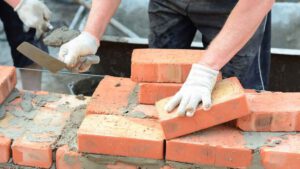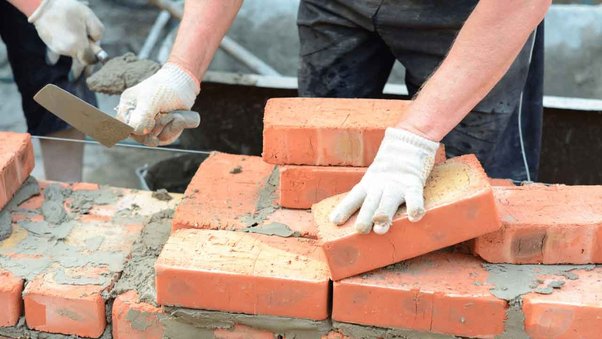Brick masonry is an attractive and durable construction material. It is easy to construct and maintain, especially in comparison to stone or concrete block masonry.
Masons lay bricks in various patterns, such as running, English, or Flemish bonds. They also use metal ties or header bricks to hold the walls together. Visit https://masonrycharleston.com/ to learn more.
Brick masonry is more expensive than other common building materials like vinyl siding and aluminum, but the material is durable and built to last. It can also be a great option for homeowners who want to keep the character of their home and are willing to pay extra for a beautiful brick exterior.
Masonry work is labor intensive and takes a long time to complete, so it’s important to consider the cost of the entire project before you start. You’ll also need to budget for additional costs, such as foundation work and the price of bricks themselves.
The price of bricks varies depending on the method of manufacture. The dry-pressed bricks are more accurate and have sharper edges than those made with the soft mud molding process, which is cheaper. Bricks are also more costly when they’re used in structures that require a high degree of engineering, such as bridges and tunnels.
Another factor that increases the cost of brick masonry is the need to construct a concrete footer for structural support. This is necessary to prevent walls from collapsing, and can add about $15 per square foot to the total construction cost.
Brick masonry requires more maintenance than other types of materials, such as wood or steel. Bricks must be cleaned regularly to remove dirt, moss, and other debris that can cause damage. A good way to clean brick is with a pressure washer or a brush and water. Once the brick is clean, it’s a good idea to apply a hydrophobic sealant to protect against moisture and dirt.
Lastly, brick is not earthquake-resistant, which makes it an unwise choice for buildings in seismic zones. It’s a good idea to consult an engineer to determine the best design for your building.
The cost of brick masonry will vary depending on the project you have in mind, but it’s generally more expensive than other materials because of the skill involved. Masons who have years of experience will charge more than those with less experience, so it’s important to get multiple quotes before hiring someone. You’ll also need to factor in the cost of any additional materials, such as cement mortar.
Durability
Brick masonry structures are highly durable and many of them remain in use for centuries. This durability is the result of both their strong outer shell and the mortar joints. However, a number of factors can lead to the deterioration of brick structures. One of the most common problems is excess moisture, which can erode bricks. This can happen even if brick walls are not exposed to direct sunlight. To avoid this problem, it is important to install a waterproof barrier under the mortar.
Masonry experts recommend using a mortar with a high water-to-cement ratio to ensure that bricks are properly adhered to each other. This ratio is also important for preventing the formation of efflorescence, which can occur when a brick absorbs too much moisture.
Another factor that contributes to the durability of brick masonry is proper stacking. Masons should make sure that all bricks are level, straight, and aligned before stacking them. This is especially important in load-bearing areas, where each brick carries a significant amount of weight. Masons can also use different bond patterns to create distinct designs for a building. Some of the most common are running, English, and Flemish bonds.
A brick is a unit of fired clay that has been cut and dried, usually in a firebox called a kiln. Traditionally, bricks were made by hand with a hammer and a trowel, but modern brickmakers use mechanical presses to produce more accurate units. They can be solid, perforated, cellular, or hollow. Bricks with indentations on one face are known as “frogged” bricks, and bricks with multiple holes that remove less than 25% of their volume are called cellular bricks.
Compared to stones and concrete blocks, bricks are lighter, cheaper, easier to work with, and more flexible. They can be used for a wide range of structural purposes, including foundations and exterior walls. They are also ideal for constructing doors and windows. In addition, they are versatile and can be combined with different materials to meet the needs of a project.
Variety
There are a number of different types of bricks and mortar that are used in brick masonry. These include clay, concrete, stone (e.g. granite, travertine, limestone), and other materials. Each type has its own advantages and drawbacks, and it is important for a mason to be familiar with all of the different types in order to determine which is best for their project. Having this knowledge can also help them determine when brick restoration is needed.
Brick masonry can be used to create a variety of structures, including walls, patios, and fireplaces. It is an ideal choice for homeowners who want a strong, durable, and cost-effective material for their homes. It is also easy to repair and maintain. Masonry has a high thermal mass, which helps to retain heat in the home and reduce heating costs.
The type of brick that is selected for a project can influence the durability and strength of a structure. Different types of brick have different properties, including the amount of water they can absorb. Bricks that are not properly sealed can wick moisture from the ground into the brick core, leading to structural damage and deterioration. It is therefore essential to select the correct bricks and ensure they are properly installed.
A masonry expert will have the experience and knowledge to choose the best brick for any project. They will know how to seal brick to prevent moisture from entering the structure, and they will use the proper mortar mixes. The right type of mortar can help protect the brick from the elements and keep it looking its best for years to come.
There are several types of bricks, including solid bricks, perforated bricks, and cellular bricks. Solid bricks are solid through their entire length and thickness, while perforated bricks have a pattern of holes that remove no more than 25% of the brick’s volume. Cellular bricks have indentations on one of the longer faces and are closed on the other.
Bricks can be moulded by hand, machine or hydraulic press. They can also be made from ground, fly ash, or recycled concrete. The most common are burnt clay, but there are also terra-cotta, engineered stone, and concrete block bricks. Other brick types include channel, cownose, hollow, and coping bricks.
Maintenance
Brick masonry is highly durable, but it’s still a good idea to inspect the facade of your home on a regular basis. This will help you identify problems and address them before they become serious issues. You’ll want to look for signs of dirt accumulation, mildew, moss, cracking, deteriorating mortar, and other problems. If you notice any of these problems, make sure to take action immediately to prevent them from getting worse.
One of the most common issues with brick is water damage. This occurs when water seeps into cracks in the masonry and freezes during cold weather. It can then expand, further damaging the brick. This type of damage can lead to the need for costly repairs and replacements. To minimize the risk of water damage, inspect your brick regularly and make sure there are no cracks or leaks. It’s also important to maintain caulking and sealants. Finally, be sure to keep vegetation such as ivy and other vines away from your brick walls. These plants can cause damage to the brick by clinging to it with their roots.
Another major problem is brick spalling. This is when pieces of brick break off the surface due to moisture intrusion. This can occur when moisture gets trapped in the brick during a freeze/thaw cycle, or it may be caused by excessive ventilation that allows moisture to enter the house. To minimize the risk of brick spalling, inspect and repair brick sills, parapets, chimneys, and copings on a regular basis.
Another maintenance item that is important for brick masonry is repointing. Repointing is the process of replacing the old, crumbling mortar between bricks. The new mortar should be compatible with the existing brick and match it in color, texture, and chemical properties. First, chisel out the old mortar from around the brick to repoint a brick. Then, clean the opening and dampen it with water or a bonding agent. Then, mix and apply new mortar to the opening. After repointing, the brick should be thoroughly rinsed to remove any residue. Finally, a high-quality brick sealer should be applied.

